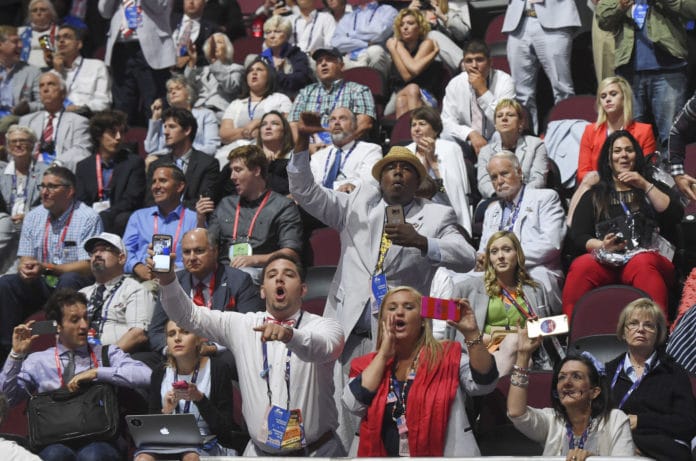Hard though it may be to fathom, there was a time, not so long ago, when political conventions were more than just TV shows. A product of Andrew Jackson’s age, when popular politics replaced a fading, more genteel style of government, nominating conventions could be rollicking, raucous affairs. They brought men (and later women) of different regions and backgrounds together to forge rough consensus on matters as charged as slavery, suffrage, political economy and immigration. A century ago, the emerging primary and caucus system opened the process up to more ordinary voters; radio and TV allowed millions to follow the conventions live. For those readers who can’t get enough of the speeches, roll calls and balloon drops, here’s where to turn.
“Fear and Loathing on the Campaign Trail ’72,” by Hunter S. Thompson
A gonzo journalist of wide renown, Thompson was one of the “boys on the bus” in 1972, when he covered the presidential campaign for Rolling Stone. His collected articles, written in a riotous, stream-of-consciousness voice, form the backbone of this famous campaign chronicle. In a typically droll passage, he offhandedly describes Gary Hart – the future senator who was then managing George McGovern’s campaign – as “a young Coloradan . . . who looks like a ski instructor.” Thompson was perceptive about politics of both the backroom and public varieties. His observations of McGovern leading up to the 1972 Democratic convention in Miami are particularly engaging.
“The Last Campaign: How Harry Truman Won the 1948 Election,” by Zachary Karabell
What’s more riveting than an account of two party conventions? How about an account of four? Karabell, who has an accessible style, writes about how Southern delegates that year stormed out of the Democratic convention in Philadelphia and launched the short-lived Dixiecrat party. Left-wing Progressives held their own convention and nominated former vice president Henry Wallace. Democrats – those who remained – tapped President Harry Truman, while Republicans chose New York Gov. Thomas Dewey, the presumed front-runner that fall. Karabell breaks down Truman’s legendary upset.
“The Manchurian Candidate,” directed by John Frankenheimer
In the culmination of this taut 1962 political thriller, starring Frank Sinatra, Janet Leigh and Angela Lansbury, Republican delegates converge on Madison Square Garden in New York to select their national ticket. Somewhere amid the cheering party boosters, a Soviet sleeper agent lies in wait, preparing to assassinate the presidential nominee. Through many twists and turns (some more plausible than others), the film uses the convention as a device to explore the dark ironies of America’s Cold War politics.
“Those Angry Days: Roosevelt, Lindbergh, and America’s Fight Over World War II, 1939-1941,” by Lynne Olson
In this volume on the events before and after the 1940 election, readers encounter two very different contentious conventions. Republicans that year stood at a crossroads: Would they follow the rigid warnings of their Midwest isolationist wing and reject Democratic President Franklin Roosevelt’s attempts to prepare the nation for war? For their part, Democrats had to decide whether to defy an unwritten tradition set in stone since 1796 and nominate FDR for a third term. Set against a backdrop of international unrest and political rancor at home, Olson’s narrative is as brisk as it is considered.
“Abraham Lincoln: A History, Volume 2,” by John G. Nicolay and John Hay
Though scholars still consult Hay and Nicolay’s 10-volume account of their late boss, few lay readers do. Yet if the larger work is dense and dated, Volume 2 contains chapters chronicling the 1860 presidential campaign that are full of drama. The authors relied on primary source documents rather than interviews long after the fact, though at times they slipped their own memories into the text. Nicolay had been present the day Lincoln was nominated and could still recall the “profound silence [that] suddenly fell upon the wigwam. . . . One could distinctly hear the scratching of pencils and the ticking of telegraph instruments on the reporters’ tables. . . . There was a moment’s pause, – a teller waved his tally-sheet towards the skylight and shouted a name, – and then the boom of a cannon on the roof of the wigwam announced the nomination to the crowds in the streets, where shouts and salutes took up and spread the news. In the convention the Lincoln river now became an inundation. Amid the wildest hurrahs, delegation after delegation changed its vote to the victor.” For these descriptions alone, the book is as winning today as when it was first published.
– – –
Zeitz, the author of “Lincoln’s Boys: John Hay, John Nicolay, and the War for Lincoln’s Image,” is at work on a book about the making of Lyndon Johnson’s Great Society.






